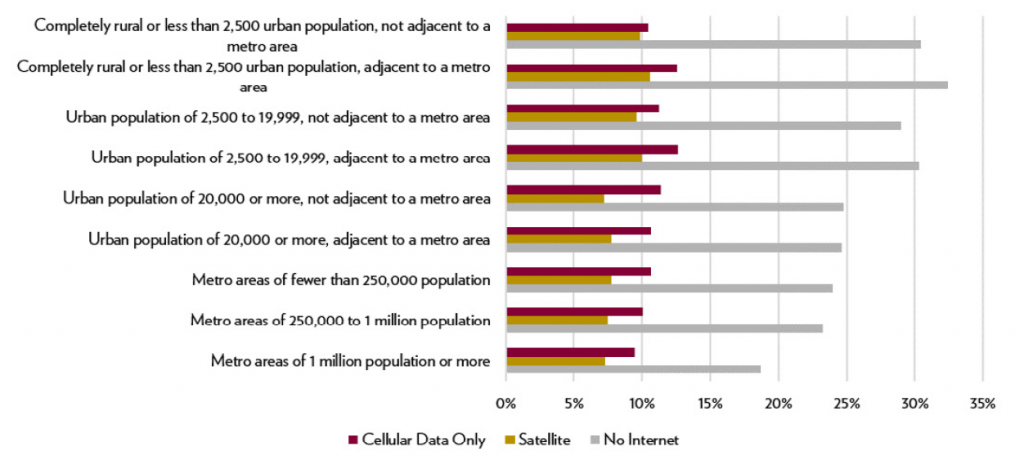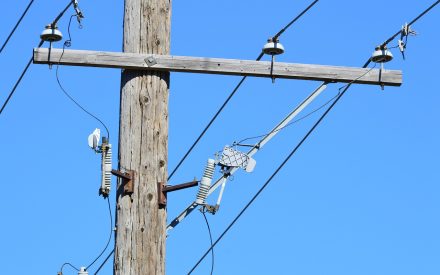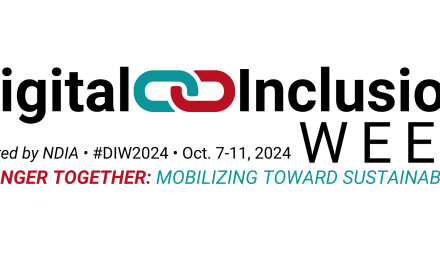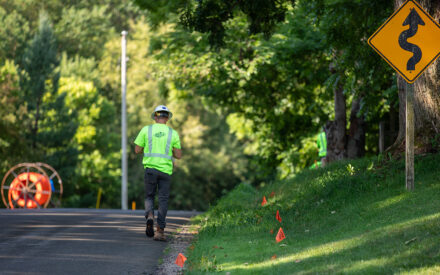As people are spending more time at home due to the pandemic, the challenge of
inadequate broadband in many parts of Wisconsin has gained greater attention. From working at home to education and healthcare, people without access to broadband are at a disadvantage. Those without broadband are often found in low-income and rural areas of Wisconsin.
Across the U.S., access to internet and, in particular, technologies that support faster upload/download speeds decline with rurality, meaning households in the most remote counties are the least likely to have broadband, especially faster speeds of broadband. For example, in urban counties, more than 90% households have broadband access (25/3 Mbps) whereas in the most rural counties, close to 70% have access. In the most rural areas of the United States, or those with the smallest populations and far from a metro area, more than one in four residents have no internet (Figure 1). With rural counties at a clear broadband disadvantage, it suggests that population density is key to understanding broadband access.
FIG 1: PERCENT OF U.S. POPULATION WITH A NON-FIXED WIRED TECHNOLOGY OR WITHOUT INTERNET ACROSS U.S. COUNTY URBAN-RURAL CONTINUUM
 However, the divide in internet access based on income may be starker than simply the rural-urban divide. Figure 2 shows households earning less than $20,000 were far more likely to be going without access than higher-income households regardless of rurality, with 40% to 60% of households at this income level lacking access. Meanwhile, for households earning more than $75,000, between just 5% and 15% are without internet. While low-income rural households do lag low-income urban households, the disparity between low-income and high-income households is generally larger than that between urban and rural.
However, the divide in internet access based on income may be starker than simply the rural-urban divide. Figure 2 shows households earning less than $20,000 were far more likely to be going without access than higher-income households regardless of rurality, with 40% to 60% of households at this income level lacking access. Meanwhile, for households earning more than $75,000, between just 5% and 15% are without internet. While low-income rural households do lag low-income urban households, the disparity between low-income and high-income households is generally larger than that between urban and rural.
FIG 2: PERCENT OF U.S. POPULATION WITHOUT INTERNET ACCESS BY HOUSEHOLD INCOME ACROSS U.S. COUNTY URBAN-RURAL CONTINUUM Together, these graphics highlight the issues of access and affordability. Some of the disparity may be due to a lack of infrastructure—some terrain requires additional cost or expertise to install broadband whether working around buildings and complex urban infrastructure or going across rugged rural landscapes, making it more difficult to provide access. Equally important though, is the issue of affordability. Even if broadband service is available, it needs to also be offered at affordable rates for people to utilize the service. In Wisconsin, the extent of these challenges varies regionally. Rural areas that lack broadband infrastructure may want to prioritize strategies and policies that encourage the development of physical resources needed to provide access. Meanwhile, more urban areas that have adequate infrastructure but still have areas with many households without internet may need to consider policies that focus on affordability.
Together, these graphics highlight the issues of access and affordability. Some of the disparity may be due to a lack of infrastructure—some terrain requires additional cost or expertise to install broadband whether working around buildings and complex urban infrastructure or going across rugged rural landscapes, making it more difficult to provide access. Equally important though, is the issue of affordability. Even if broadband service is available, it needs to also be offered at affordable rates for people to utilize the service. In Wisconsin, the extent of these challenges varies regionally. Rural areas that lack broadband infrastructure may want to prioritize strategies and policies that encourage the development of physical resources needed to provide access. Meanwhile, more urban areas that have adequate infrastructure but still have areas with many households without internet may need to consider policies that focus on affordability.
This work was supported by a grant from the United States Department of Commerce Economic Development Administration in support of Economic Development Authority University Center.Any opinions, findings, conclusions or recommendations expressed in this material are those of the authors and do not necessarily reflect the views of the U.S. Department of Commerce Economic Development Administration.

















